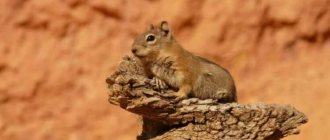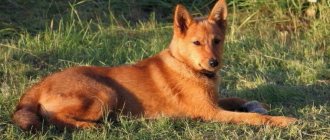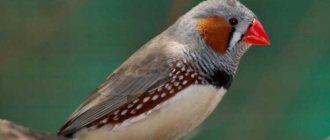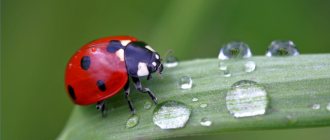Among the many species of ornamental birds, small parrots are the most sought after. This popularity is explained not only by the simplicity of maintenance, but also by the amount of positivity emanating from these birds. Miniature birds are funny, cute and smart. They are excellent conversationalists: they will always listen to their owner and even “support” the conversation. From this material you will learn about the tiniest parrots on the planet: what they look like, where they live in nature, how long they live and what conditions they need.
Varieties of small parrots
It is recommended for beginner breeders to buy small parrots because they are not difficult to maintain and care for compared to keeping large parrots. They are also easy to breed.
Wavy
One of the most popular pets is Australian budgerigars. The natural color is light green, but through breeding you can find around 200 colored varieties.
The life expectancy of these active birds in good breeding conditions can reach 15-20 years.
Frilled parrots are excellent chatters. If they participate, they can learn and easily recreate dozens of words and phrases. However, only boys have such skills.
Rather a talkative and noisy species of bird. They may sneak around during the day, cleverly, trying to eavesdrop on TV or people talking. Very playful and friendly. Non-constructive requirement regarding living conditions, getting along well with children. By the way, if you are thinking about what parrots allow for a child, a budgie is the best option.
Passeriformes
This type of small parrot, coming from America, is also easy to keep, but is not very popular among breeders.
The natural color of the common parrot is green. Thanks to breeding, birds with blue, cream and yellow plumage appeared.
These pets are suitable for people who are sensitive to noise - these violent birds will not disturb owners. However, they can be aggressive, especially during the breeding season. Even large parrots can attack Uparte and Dauntless to defend their territory. Therefore, do not stick to the same cage with more than two people.
They are friendly to their owners, very playful, curious and social, you have to give them a lot of attention. They can imitate human speech and sound like Triles.
They live at home until they are 20 years old.
Woodpeckers
These parrots are the smallest of all existing ones, their size does not exceed 10 cm. Of course, their weight is also small - 13 grams. Because woodpeckers are so small and clever at hiding among leaves, their lifestyle is poorly understood.
The main color of the plumage is green, with a variety of blue, yellow, red, orange and gray brown feathers. Colors depend on the genre.
The short tail with rounded or simple shapes resembles the baked tail of a woodpecker, which is why these birds were called "woodpeckers".
These birds cannot live at home. Sometimes you can see them in zoological gardens. It is believed that the average lifespan of a woodpecker is 15 years.
Lovebirds
The small parrot is the second most popular species. They were called "inseparable" because it was believed that the partners found a mate and remained faithful throughout their lives. However, in reality this is not entirely true. If one of the partners dies, the other gets a new one after some time.
Homeland Africa and Madagascar. In nature, you can find them near water sources. In captivity, he can live 15-20 years.
They resemble sparrows or changelings in size; Their maximum length is 17 cm, of which 10 cm is the tail, which appears small compared to the body.
These small parrots are very beautiful: the main plumage is light green, and the chest, neck and head are decorated with contrasting plumage in yellow, red, green or blue, depending on the species. Today, thanks to selective breeding, cobalt blue, white and bright yellow birds can be found.
These active birds are very jealous and can attack each other; they are not afraid of larger birds. These birds live in harmony when kept in pairs.
Teaching pigeons to reproduce human speech is almost impossible. If a man systematically and for a long time accustoms his beloved bird to human speech, then he will say no more than 15 words as much as you can count on.
Fig
These Australian parrots received such an unusual name because of their great love for the fruits of the fig tree. It is almost impossible to find such birds at home.
Their way of life in the wild is poorly studied, since these birds do not make noise or scream so as not to detect their presence. And the size and color of their plumage perfectly camouflages agile birds and hides them from prying eyes.
Considered one of the smallest parrots on the continent:
The main color of the plumage is green. Depending on the type, the feathers on the body can be colored red, black, yellowish, blue, cyan, and sometimes orange.
It is believed that these feathered birds can live 15-20 years.
Bottle with drinker
Such an accessory will come in handy during street walks. It does not take up much space, weighs little and does not hinder movement. But you can offer the dog to quench his thirst at any time, and not wait until he starts drinking from a dirty puddle or lake overgrown with mud.
The device consists of a water container and a bowl equipped with a dispenser button. It allows you to release as much liquid from the bottle as the animal needs to quench its thirst. Sold in two volume options - 350 and 550 milliliters.
Price – 475 – 584 rub.
Another model of the same device has a folding shape, which makes it easier to carry. The transformer connects the bowl and the bottle, securely fixing them in such a compact state. The durable polymer material has good shockproof properties and can even resist dog teeth. True, this struggle will not be long and - if the owner is careless - then all the liquid will end up on the ground.
Volume 250 ml.
Cost – 133 – 148 rubles.
I like1I don't like
Care and maintenance of small parrots
The most important thing when buying a feathered bird is to buy a young chick. Living with older birds can be difficult because they already have certain behavioral habits. If the previous family treated them poorly, you may end up with a wild bird that is either afraid of people or aggressive towards them. In addition, buying an old parrot does not allow you to enjoy the delights of life with small birds for at least half a decade.
Cell
Buy a rectangular cage large enough to allow the bird to spread its wings freely without touching the walls and to allow the bird to flutter from place to place. The cage should have:
Hanging a mirror in a parrot's cage is not always a good idea. Some birds are quite aggressive towards it. Indifferent reflexes do not respond to communication and attack; because of this attitude, the bird may become sad. Moreover, a parrot will never begin to reproduce human speech by cooing at its reflection in the mirror.
The cage should be placed with at least one side close to the wall, as this will create a feeling of security. Don't place the cage too low as this can make your parrot anxious and depressed. If you place the cage too high, the bird will feel like it is in a dominant position. Therefore, the cage must be placed in such a way that the bird sitting on the perch is at the level of our face.
Try to stick your hands into the cage as little as possible. Many parrots perceive this as an invasion of their territory. If you want your pet to wander around the apartment, lure him with a treat or a brightly colored toy, or let him out of the cage when he wants. A crate with a retractable tray allows you to clean your pet's house without disturbing him.
If you have just purchased a bird, do not let it out of its cage until it has acclimatized. This will take some time, at least 2 weeks. If you decide to let your pet roam around the room, read about how to return your parrot to its cage.
Diet
These little parrots have a very fast metabolism, so they need to be fed every 3 hours or so. It is advisable that they have food available all the time.
The diet of birds should be varied. The species described are grain eaters, since the basis of their diet is a grain mixture. Enrich your diet with fresh vegetables, herbs and fruits. The varieties of parrots given are:
Warning. Black rye bread, spices, herbs, sugar, salt, persimmons, mangoes, papaya, meat, fish, dairy products, and human food are prohibited in the parrots' diet.
Place branches and shoots of fruit trees in the cage. Little parrots love to chew on them. This helps them sharpen their beaks, provides them with nutrients and gives them great pleasure.
Small parrots, despite their small size, are loyal friends who subtly sense the state of their owner. Thanks to their cheerfulness and pranks, they can dispel sadness and cheer up. In return they expect care, attention and love. When these agile and beautiful birds arrive home, your life will change forever.
Watch this video to see how budgies can talk:
Whom to choose
If you plan to purchase a small parrot, then you can choose different breeds, focusing on your own preferences.
But at the same time, the recommendations of experienced breeders are taken into account:
- if there is a desire to teach a wavy to speak, then it is advisable to buy a wavy, and it should be kept alone, not in pairs;
- if a person wants the house to never be quiet, then it is important to choose a couple of lovebirds who chirp or sing a lot, and it is also always pleasant to observe the unusual habits of these birds;
- if a person wants a pet to be calm and pleasant in communication, then he buys a passerine parrot, which not only imitates human speech, but also screams a little.
When choosing, the cost of the parrot is additionally taken into account, since the price for different breeds varies significantly.
Small parrots: types, features, interesting facts
Of the many species of ornamental birds, small parrots are in greatest demand. This popularity is explained not only by the ease of care, but also by the amount of positive emotions emanating from these feathered birds. Miniature birds are fun, cute and cute. They are excellent conversationalists: they always listen to their owner and even “support” the conversation. From this material you will learn about the smallest parrots on our planet: what they look like, where they live in nature, how long they live and what conditions they need.
Description
The habitat of parrots is the tropical and subtropical regions of America and Australia. Various species have their own special, unique color, size, and habits. These birds have won the hearts of bird lovers. And all thanks to their cheerful disposition, curiosity, restlessness, and positivity that they radiate to others.
Types of the smallest parrots
If you want an exotic bird, pay attention to representatives of small breeds: woodpeckers, sparrows, budgies and lovebirds. They are easy to care for. The small size of birds is not their only positive feature. They easily adapt to life close to humans. Let's start with woodpeckers - the most graceful and inconspicuous birds, about which little is known.
Woodpeckers
Living representatives of the smallest parrots in the world live on the islands of New Guinea, in the tropical forests. The lifestyle of these birds has been little studied due to their small size: an adult bird is 7-10 cm long and weighs only 13-15 g. Scientists have found that these birds are well adapted to environmental conditions.
Because of its short spade tail, the parrot received the name woodpecker.
This is interesting! The camouflage coloring of the plumage helps the birds to be invisible against the background of trees. The body is covered with green feathers with black spots, the belly is yellowish.
Passeriformes
Externally, these birds resemble sparrows: in size, body shape and wedge-shaped tail. This is where their similarities end.
Passerine parrots live in the northwestern part of South America. Numerous herds of them can be seen in mangrove forests.
Wavy
In nature, budgerigars live on the Australian continent and lead a gregarious lifestyle. They feed on grains, grass seeds, nuts and fruit trees.
Budgerigars are the most attractive pets. They have an attractive appearance and a well-defined body, length from beak to tail 20-25 cm, weight 40-50 grams. Naturally colored individuals are covered in yellow-green feathers with black spots. The main feature is the wavy pattern on the head and back.
Attention! During the breeding work, breeders identified white, yellow, blue, purple colors - a total of 30 primary and more than 100 secondary mutations.
A characteristic feature of budgies is that they can be taught to speak. Perhaps due to this property, the popularity of wigglers is growing from year to year.
Lovebirds
Multi-colored love birds live in Africa and on the island of Madagascar. There are 9 species of love birds, each with their own characteristics. For example, Fischer's lovebird has green plumage on the lower half of its body. The feathers on the chest and head are red with an orange tint, and on the belly they are yellow.
The weight of an adult bird reaches 50 g, and the body length is 20 cm. The tail is short, slightly rounded. The beak is thick, strong and pointed. An interesting feature of love birds is the hairless area around the eyes. Black iris on a white background.
There is an opinion that love birds received this name because of their sensitivity. According to legend, if one bird dies, its mate will miss it for the rest of its life.
Blue-and-yellow macaw / Ara ararauna
A beautiful exotic bird nests in the forests of Panama, northern Paraguay and Brazil. Lived on the island of Trinidad, but today is considered extinct in this part of the planet.
It reaches a length of 75 to 90 cm, and a wingspan of almost 89 cm. This species has a long, beautiful tail. The length of the tail feathers reaches 51 cm. The bird has a magnificent bright color. The head and part of the body are bright blue, and the sides are orange and yellow. The forehead with greenish feathers stands out against a bright background.
They prefer to live in pairs or alone and never gather in flocks.
Did you know that this species of parrot is one of the longest living animals on the planet? Read more about this in our article on thebiggest.ru.
2
Keeping small parrots
Woodpeckers are very rarely bred at home - it is difficult for them to adapt to life in captivity. The situation is completely different with passerines: these feathered animals prefer a controlled existence. They like the proximity of songbirds, but do not get along with large individuals. The most popular representatives of the world of winged birds - wolfhounds and love birds - behave well in the company of people. Intelligent birds are easy to tame and remain loyal to their owner.
Cage or aviary?
If you plan to keep small parrots alone, buy a small cage. Tiny birds are unpretentious and can feel good in a house measuring 25/30/35 cm. It is important to take care of the safety of the livestock: the aviary must have perches made of natural materials, clean feeders and drinkers.
An aviary should be considered if there are several birds. The bird is more accustomed to living in a herd, so it will be happy to live in a spacious room. For example, passerine parrots need an aviary, but they cannot be combined with wolves.
A characteristic feature of enclosures is that they do not need to be allowed out for walks. The length of each wall of the casing is at least one meter - enough for flights.
Required diet
Food for wild parrots includes various seeds, some grains, herbs, and fruits. These ingredients are a must-have in your pet's diet. You can use ready-made dry mixtures with a predominance of millet and canary. The digestive system can also cope with oat and wheat grains, but only in a crushed state.
Once a week, animals should receive animal protein food: low-fat cottage cheese, boiled egg. In nature, very active birds catch and swallow live insects. Owners of ornamental birds can purchase packaged mealworm larvae from a pet store. Let's not forget about juicy food: fruits, vegetables, green mass.
Tama the Cat: Train Station Master
This happened in the early 2000s, when the unprofitable Kishi station in the Japanese city of Kinokawa was almost closed due to unprofitability. Residents, of course, protested, but it is unlikely that their efforts would ultimately be crowned with success. The situation was saved by a local cat named Tama, who loved to bask in the sun near the train station. The station manager noticed how enthusiastically passengers reacted to this couch potato and gave him the official position of caretaker. The cat was given a uniform cap, a badge and a monthly salary in the form of free food.
The duties of the newly minted minister included advertising functions. He greeted passengers, allowed himself to be petted, and was always somewhere on the platform. It must be said that this policy very quickly led to commercial success. Tourists began to come to Kishi station just to look at the railway cat and take pictures with him. From that moment on, there was no further talk about closing the station.
But the unusual cat's career did not end there. In 2008, Tama became a supervisor and was charged with monitoring the performance of professional duties by staff. That same year, the cat was knighted. Another year later, according to the project of the famous designer Eiji Mituku, the railway included in the schedule a train dedicated to the legendary animal. The carriages were painted with views of Tama, the locomotive was decorated with his muzzle, and meowing signaled the opening (closing) of the doors. But this did not become the crown of the cat’s career.
A year later, Tamu was appointed third party of the railway company, entrusted with the post of executive director. By his old age, it was already difficult for him to work every day, and the management allowed the elderly cat to come to work 3 days a week.
Tama died at the ripe old age of 14. But even after this, the career did not end. Posthumously, the cat was elevated to the rank of Eternal Station Master, thus perpetuating his memory. After all, over the years of work, this four-legged employee has brought considerable income to his company. The tourist flow through the station increased to 300 thousand people annually, and the financial indicator amounted to more than 1.1 billion Japanese yen.
The company's management did not want to accept the loss of such a profitable and already promoted advertising brand. Tama was replaced by Nitama (the second Tama). True, later with the third cat there was an overlay. He was found at Okayama Station and offered a position in Kishi. But the owner did not agree to the move. Next came Yontama (the fourth Tama), who had already had to undergo a special training course before taking her place on the platform of the railway station.
And the flow of tourists wanting to take a photo with the legendary heirs of the first Tama still does not dry out.
I like2I don't like
How long do small parrots live?
Establishing the lifespan of birds in the wild is quite difficult. Pets can live in human company for quite a long time, from 5 to 20 years. Romance novels last the longest. They live 15-18 years if suitable conditions are created for them. Wigglers live a little shorter, around 8-10 years. Passerines and woodpeckers can be said to be at risk of premature death due to their small size. However, under favorable conditions, small birds live in captivity for 5-8 years or even longer.
Among the small parrots, budgies and lovebirds stand out. The popularity of these birds is undeniable. They clearly outweigh woodpeckers and parrots.
Green warbler (10 cm)
The green warbler is the size of a matchbox, its length is 10 cm. Weight is no more than 6 g. Males and females are practically indistinguishable. These migratory small olive-colored birds inhabit the mountain forests of mid-latitudes in May and fly to India for the winter. They feed on insects, spiders, and small mollusks. They make nests in hollows, crevices, and abandoned burrows. The spacious bag-shaped house, up to 25 cm long, has enough space for three chicks and both parents.
Shy birds do not take root well in captivity; they prefer to live in pairs rather than in a flock. They nurture their offspring until autumn. Birds flock together only before the seasonal migration. The male delights with his sonorous singing from May to the end of July, the female is silent and rarely makes sounds.
The smallest parrots in the world
Small parrots include not only the typical budgies and lovebirds, but also representatives of less common species.
Woodpeckers
This is the smallest parrot in the world. It grows up to 10-12 cm and weighs only 12-15 g. The bird has a compact body, a relatively large head, claws, a slightly curved beak and a short tail, similar to that of a woodpecker. The plumage of this small parrot is dominated by shades of green mixed with brown, black, yellow, blue or red.
It lives in the forests of New Guinea and Indonesia, settling on the treetops. In captivity, the woodpecker parrot easily gets used to humans, but cannot be completely tamed.
Passeriformes
These small parrots live in the mangrove forests of northwestern South America. They grow up to 15 cm and weigh only 30-35 g. The birds have short legs with light toes, a round head, a thickened beak, a wedge-shaped tail and lush bright plumage. The colors of these birds are dominated by turquoise, green and blue shades.
Small birds are easy to tame; they remember 10-15 words. Small parrots are generally sociable and need companionship. Therefore, it is better to keep them in pairs.
Wavy
The long tail makes these birds look like medium-sized parrots. In reality, they grow up to 20 cm and weigh about 40-45 g.
The natural plumage color of budgerigars is yellow-green with small black spots and a wavy pattern on the head and back. However, breeders have managed to significantly expand their range and breed white, yellow, blue and purple birds.
In the wild, small parrots live in savannas, eucalyptus groves and semi-deserts of Australia. In captivity, these birds easily get used to being handled and even learn to repeat long words.
Lovebirds
These small parrots grow up to 10-17 cm and weigh about 40-60 g. They are distinguished by a strong structure with a short tail, a large head and a strong beak. The color of lovebirds is predominantly green in combination with yellow, red or blue.
Social birds do not tolerate loneliness and should be kept in pairs. They love to swim, sunbathe and taste everything.
Fig
These parrots are small, growing up to 14 cm and weighing no more than 35 g. They are green in color with orange, blue, blue, yellowish, black or red spots. These clever little parrots lead a secretive lifestyle and are almost never kept in captivity.
They are native to New Guinea and Australia and owe their name to their love of the fruit of the fig tree.
Toys
The pet store provides a wide range of toys for parrots. Small birds also love to have fun with them. There are gaming devices:
- for grinding down the beak and claws on the paws;
- climbing, hanging, climbing;
- musical, producing different sounds;
- developing;
- sports.
Toys are changed as they become unsuitable. Your pet must have them.
Lovebirds - All about the breed of parrots | Parrot breed - Lovebird
Keeping small parrots
Birds of small breeds require no less attention and care than medium-sized parrots. A native of the tropics needs a special microclimate to feel comfortable. Therefore, the room where the small parrot lives should be warm, bright and dry.
Cage or aviary
Small species of birds do not need such a spacious apartment as medium and large parrots. The standard dimensions of a cage for small birds should be 25x30x35 cm. The aviary is more suitable for keeping several animals. Inside you should place drinking bowls, feeders, mineral stone, wooden perches and toys.
On the fields. The cage should be positioned so that at least one side is adjacent to the wall. Thanks to this solution, small parrots will feel safe.
Complete diet
Small parrots have a fast metabolism and require frequent feeding. Birds should be fed at intervals of no more than 3 hours. It is recommended to enrich the diet with grain mixtures, fresh vegetables, herbs and fruits. For variety, you can feed small parrots with boiled eggs, unsalted semolina, low-fat cottage cheese and seeds. And so that birds can trim their beaks themselves, they should be given branches of fruit trees.
Small parrots should not be fed:
Red Macaw
The top three is opened by a stunning bird with a fantastically striking appearance. Its feathers can be colored in all the colors of the rainbow and in countless shades. It can rightly be called a branded parrot, because it is often found in commercials and films about pirates. The body length ranges from 90 to 95 cm, the tail – 60 cm. The wingspan is up to 40 cm.
The red macaw is a pest because it loves to feed on plantations and fields, which causes significant damage to the crop. The diet includes nuts, a variety of fruits, young shoots of bushes and trees. As for keeping in captivity, this is virtually impossible due to its large size and loud voice. The red macaw is trainable and is able to remember and reproduce about 100 words. The average lifespan is 60 years.
Health and life expectancy
The lifespan of small feathered birds ranges from 5 to 20 years and depends on what species they belong to. Woodpeckers have the shortest lifespan. But these birds can live up to 15-18 years.
Small parrots do not have a strong immune system and often contract infections. Therefore, at the first symptoms of the disease or any deviations in the behavior of birds, you should contact a veterinarian.
Due to their small size, small parrots often get injured when they get tangled in curtains or bump into window frames. They may also be preyed upon by other pets or abused by their owner's children. Therefore, the bird should not be released from the cage unattended.
Small parrots are quite curious and often drown in pots of water, get poisonous fumes or get burned. They also have a weak heart and are prone to stress. That's why you should protect these birds from emotional outbursts.
Wren, 12 cm
Another name for the bird is rootstock or nutcracker. It is the only representative of the wren family. You can meet the tiny creature in the countries of America, Eurasia and the north of the African continent.
Wrens are distinguished by their loud singing, which is similar to the chirping of a canary. They settle in deciduous forests, where there is a lot of dead wood, dry grass and shrubs. Occasionally, birds build nests in reeds near water bodies, on the roofs of abandoned houses and barns. Wrens feed on invertebrates, insects, berries and small fish. If threatened, they fall to the ground and hide in the grass.
Buffy Hummingbird
This cute miniature bird opens the list of representatives of the hummingbird family that settled in the warm regions of the Western Hemisphere. But this is the only species of hummingbird registered in Russia.
They live in the subtropical region on Ratmanov Island, and Soviet scientists first collected information about them in 1976. its natural habitat is North America, but there is evidence that the small bird could fly as far as Wrangel Island.
They grow no more than 8.6 cm, and weigh only 8 grams. They are very hardy and can easily tolerate frosts down to −20°C, as well as travel long distances.
2











